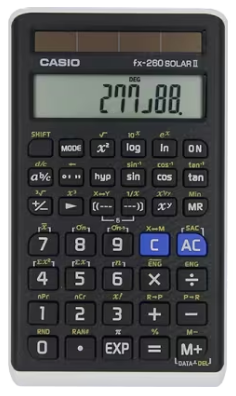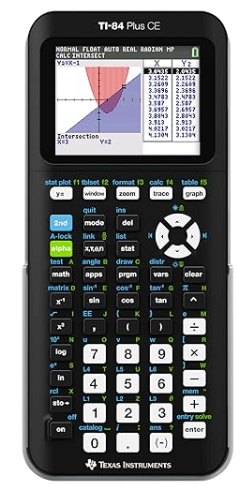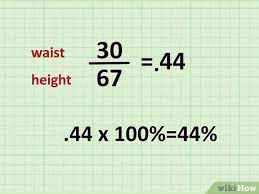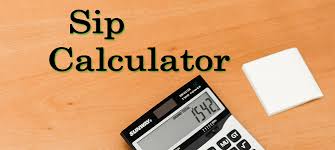Understanding ACT Calculator Policy
Are you planning to take the ACT (American College Testing) this year ? .Do not you know “What Calculators Are Allowed on The ACT” ? . If so, you’ve likely heard that calculators can be a valuable tool during the math section of the test. However, not all calculators are allowed. To ensure that you’re well-prepared for the ACT and don’t encounter any unexpected issues on test day, it’s crucial to understand the calculator policy in detail.
ACT Calculator Policy : What You Need to Know
The ACT places a strong emphasis on its calculator policy. It’s essential to adhere to these rules to maintain a level playing field for all test-takers and ensure a fair testing environment. Let’s dive into the specifics of the ACT calculator policy for this year.
Approved Calculator Types – What Calculators Are Allowed on The ACT ?
The ACT permits the use of four main types of calculators:
- Basic Calculators: These are simple, non-programmable calculators capable of performing basic arithmetic functions like addition, subtraction, multiplication, and division. They are widely accepted on the ACT.
- Scientific Calculators: Scientific calculators are allowed as long as they are non-programmable and do not possess advanced graphing capabilities.
- Graphing Calculators: You can use graphing calculators, such as the popular Texas Instruments TI-84 Plus, provided they meet specific ACT requirements. It’s important to note that graphing calculators with built-in Computer Algebra System (CAS) functionality are not allowed.
- ACT-Approved Calculators with CAS: A limited number of ACT-approved calculators with CAS functionality are permitted. Examples include the Texas Instruments TI-Nspire CAS and the HP Prime.
Required Modifications
Certain calculators may need modifications to comply with ACT regulations. These modifications are intended to prevent unfair advantages and distractions. Here are the key modifications:
- Remove CAS Functionality: If your calculator has the capability to solve algebraic operations involving variables (CAS functionality), it must be disabled or removed.
- Remove Paper Tape: If your calculator has a paper tape feature, you should remove the tape.
- Disable Sound: If your calculator emits sound, ensure that the sound is disabled or turned off.
- Cover Infrared Data Port: If your calculator has an infrared data port (a light-emitting component), cover it with a thick, opaque material like duct tape or electrician’s tape.
- Remove Power Cord: If your calculator uses a power cord, the cord should be disconnected during the test.
Calculator Usage During the ACT
Calculators are only allowed during the math section of the ACT. They are not permitted in any other section of the test, including English, Reading, Science, and the optional Writing section. Therefore, it’s essential to use your calculator strategically and efficiently during the designated math portion.
Approved Calculator Brands and Models
For a comprehensive list of ACT-approved calculators, you should refer to the official ACT website where you can find up-to-date information on specific brands and models that meet the ACT’s criteria.
Calculators Allowed on the ACT: Exploring Types and Examples
Now that we’ve covered the ACT’s calculator policy, let’s explore the different types of calculators allowed on the ACT, along with examples to help you make an informed choice.
1. Basic Calculators
Example: Casio FX-260 SOLAR II
Basic calculators are the simplest and most straightforward. They are ideal for performing basic arithmetic calculations, making them suitable for the ACT’s math section. These calculators typically include functions for addition, subtraction, multiplication, division, square roots, and percentages. Since they lack advanced features, they require no modifications for ACT compliance.

2. Scientific Calculators
Example: Texas Instruments TI-30X IIS
Scientific calculators are more advanced than basic calculators and offer additional functions such as exponents, parentheses, trigonometric calculations, and logarithms. However, they are still non-programmable and suitable for use on the ACT, provided they do not have CAS functionality.
3. Graphing Calculators
Example: Texas Instruments TI-84 Plus
Graphing calculators are powerful tools that can plot coordinates and graph functions. They are particularly useful for solving complex equations, graphing functions, and analyzing data. However, not all graphing calculators are allowed on the ACT. Only those without CAS functionality are permitted.

4. ACT-Approved Calculators with CAS
Example: Texas Instruments TI-Nspire CAS
These calculators, while more advanced, are allowed on the ACT, provided they meet the specific requirements outlined by the test administrators. They can handle complex algebraic operations, making them valuable for certain math tasks. If you choose to use a calculator with CAS functionality, ensure it complies with the ACT’s regulations.
List of ACT- Approved Calculator Brands and Models -What Calculators Are Allowed on The ACT ?
To provide you with the most up-to-date information, we recommend referring to the official ACT website for a detailed list of ACT-approved calculator brands and models. This list is subject to change, so it’s crucial to verify the latest updates before test day.
ACT Prohibited Calculators: What to Avoid
To prevent any issues on test day, it’scrucial to be aware of the calculators that are explicitly prohibited by the ACT. Here’s a list of calculators to avoid:
Texas Instruments:
- Model numbers beginning with TI-89 or Ti-92
- TI-Nspire CAS (non-CAS TI-Nspire calculators are permitted)
Hewlett-Packard (HP):
- HP Prime
- HP48GII
- Model numbers beginning with HP 40G, HP 49G, or HP 50G
Casio:
- fx-CP400 (ClassPad 400)
- ClassPad 300 or ClassPad 330
- Algebra fx 2.0
- Model numbers beginning with CFX-9970G
In addition to these explicitly banned models, the ACT also prohibits calculators with a QWERTY format letter keyboard. It’s essential to ensure that your calculator does not possess any of these features to avoid any complications on test day.
ACT Calculator Recommendations: Tips for Success
Now that you have a solid understanding of the ACT calculator policy and the types of calculators allowed, let’s delve deeper into some key recommendations to ensure your success on test day.
5. Don’t Overspend on a Calculator
When choosing a calculator for the ACT, it’s important to select one that meets your needs without breaking the bank. While there are advanced and expensive graphing calculators available, if you aren’t already familiar with their advanced features, investing in one might cost you more time than it saves. A more budget-friendly option is the Casio TI-30, which costs less than $20 and covers all the necessary functions you’ll encounter on the ACT math section. Simplicity and ease of use can be more valuable than having a high-end calculator with features you’re not comfortable with.
6. Practice with Your Calculator
Regardless of which calculator you choose, it’s crucial to become well-acquainted with its functions and features. Familiarity with your calculator will allow you to use it most effectively during the test. Don’t leave this practice to the last minute. Dedicate time to practice with your calculator well in advance of the test date. Work through math problems and equations using your calculator to build confidence and speed.
7. Ensure Your Calculator Is Fully Charged or Bring Extra Batteries
Imagine having the perfect calculator, but it dies during the test! To avoid this scenario, make sure your calculator is fully charged before heading to the test center. If your calculator relies on batteries, bring extra batteries with you. Having a calculator with no power will do nothing for you, so plan ahead.
8. Strategize Calculator Usage
While you’re permitted to use a calculator during the math section of the ACT, it’s important to strategize when and how to use it effectively. Here are some tips:
- Don’t Rely on It Too Heavily: For the first section of the math test, which includes basic algebra, linear equations, and functions, consider doing mental calculations. Using a calculator for these simpler questions might slow you down. Mental math can often be faster.
- Use It for Complex Tasks: Save your calculator for the latter two sections of the math test, which involve intermediate algebra, coordinate geometry, geometry, and trigonometry. These sections often require solving for area, circumference, and other complex functions, where a calculator can be a valuable asset.
- Consider Backsolving: In some cases, especially with multiple-choice questions, it might be faster to use your calculator to “backsolve.” This means plugging answer choices into the original question to see which one works. It can save time compared to solving the equation step by step.
9. Can You Have More Than One Calculator?
The ACT allows you to bring more than one calculator to the test center, but there’s a catch: you can only have one on your desk at any given time. Why bring more than one calculator? Having a backup can provide you with extra security and peace of mind in case your primary calculator malfunctions or runs out of power.
Be Ready For The ACT With SoFlo Tutors
Now that you are well-versed in the calculators allowed on the ACT and have a comprehensive understanding of the ACT calculator policy, you’re one step closer to test success. Consider practicing with your chosen calculator alongside SoFlo Tutors. Our Ivy League tutors specialize in ACT preparation, and we’ve seen students improve their scores by an impressive 110 points after just 10 sessions. With our flexible scheduling and online sessions, you can connect with our tutors at your convenience, allowing you to prepare effectively and confidently.
Frequently Asked Questions
To provide further clarity on the topic, let’s address some frequently asked questions related to calculator usage on the ACT:
Q1: Can You Use a Calculator on the ACT?
A1: While ACT questions are designed to be solvable without a calculator, you are allowed to use an approved calculator during the math section of the test. It is the only section where calculator usage is permitted.
Q2: What Calculators Are Allowed on the ACT?
A2: The ACT allows the use of any 4-function, scientific, or graphing calculator, as long as it is not on the prohibited list and is modified if needed. These calculators should not have CAS functionality.
Q3: What Calculators Are Prohibited for ACT?
A3: The ACT explicitly forbids calculators with CAS functionality, meaning calculators capable of solving and simplifying algebraic equations. Additionally, calculators with alphanumeric keyboards are also prohibited.
In summary, understanding the ACT calculator policy and choosing the right calculator can significantly impact your performance on the math section of the test. By following the guidelines, practicing with your calculator, and strategizing its use, you can maximize your chances of success on the ACT and take a confident step toward your academic goals. Remember, preparation is key, and with the right tools and knowledge, you can excel on test day and pave the way for your future educational endeavors.
Exploring ACT Calculator Features
Now that we’ve discussed the types of calculators allowed on the ACT and the associated policies, let’s explore some useful features that can help you make the most of your calculator during the math section of the test.
1. Fraction Calculations
Many approved calculators, including scientific and graphing calculators, have built-in features for handling fractions. These features can be incredibly valuable when dealing with questions that involve fractions, ratios, or proportions. Make sure to familiarize yourself with your calculator’s fraction capabilities.
2. Trigonometric Functions
For questions involving trigonometry, a calculator that supports trigonometric functions like sine, cosine, and tangent can be a game-changer. These functions simplify calculations related to angles, triangles, and circular motion. A scientific calculator is typically equipped with these functions.
3. Memory Functions
Calculators often come with memory functions that allow you to store and recall numbers. These functions can be helpful for temporarily saving intermediate results during multi-step calculations. Learn how to use the memory features of your calculator efficiently.
4. Statistical Calculations
Graphing calculators, in particular, excel at statistical calculations. They can help you analyze data, find means, standard deviations, and even create scatter plots and regression models. If you’re comfortable with these functions, you can save time on complex statistical questions.
5. Equation Solvers
Some advanced graphing calculators come with equation-solving capabilities. These calculators can solve equations with multiple variables, which can be handy for tackling algebraic problems quickly. However, ensure that the calculator you use adheres to ACT guidelines regarding equation solvers.
Using Your Calculator Effectively
Equipping yourself with the right calculator is just the first step. To truly succeed on the ACT, you must also know how to use it effectively. Here are some strategies to maximize the benefits of your calculator:
1. Practice, Practice, Practice
Familiarity with your calculator is key to efficient use. Spend time practicing with it on a wide range of math problems. Explore its various functions, experiment with different features, and become confident in its capabilities.
2. Understand the Manual
Take the time to read the user manual or guide that comes with your calculator. Manufacturers provide detailed instructions on how to use specific functions. Understanding these instructions can help you save time during the test.
3. Organize Your Calculator
Ensure that your calculator is organized and set up for efficiency. Clear previous calculations, reset memory functions if needed, and have a plan for how you’ll use it during the test.
4. Know When Not to Use It
While calculators are valuable tools, there are instances when mental calculations may be faster. Learn to identify situations where a calculator might slow you down and opt for mental math instead.
Calculator Security and Test Day Preparation
On the day of the ACT, it’s essential to be well-prepared, not just in terms of your calculator but also in ensuring its functionality and compliance with ACT rules. Here are some steps to take before and on test day:
1. Verify Calculator Functionality
Double-check that your calculator is fully functional, including battery or power supply. It’s a good idea to have fresh batteries or a fully charged battery on hand.
2. Familiarize Yourself with Test Center Policies
Different test centers may have specific rules or procedures regarding calculator use. Be aware of any additional guidelines provided by your test center, and arrive early to allow time for security checks.
3. Bring Extra Batteries
If your calculator relies on batteries, carry spare batteries with you. A calculator without power is of no use during the test.
4. Arrive Early
Arriving at the test center early allows you to calmly go through security checks and set up your calculator. Rushing can lead to anxiety and mistakes.
5. Keep Your Calculator Secure
During breaks or when not using your calculator, keep it securely stored to prevent any accidental damage or loss.
6. Stay Calm and Confident
Finally, on test day, stay calm and confident. You’ve prepared well, and your calculator is ready to assist you. Trust your practice and your calculator to help you tackle the ACT math section effectively.
Conclusion
In conclusion, understanding which calculators are allowed on the ACT and how to use them effectively is a crucial component of your test preparation. By choosing an approved calculator, practicing with it, and being familiar with its features, you can gain an advantage on the math section of the ACT. Remember that while calculators are valuable tools, they should complement your math skills, not replace them. There are instances where mental math is faster and more accurate. Strategically using your calculator and knowing when not to use it is key to success. On test day, ensure that your calculator is in good working condition, and follow all test center rules and guidelines. With careful preparation and the right calculator by your side, you’ll be well-equipped to tackle the ACT math section and achieve your academic goals.





